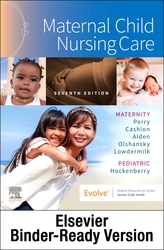「重要なお知らせ:日本語書籍をご購入いただき、eLibraryをご利用の皆さまへ」
エルゼビアは、より快適にサービスをご利用いただくため、システムの重要なアップデートを実施いたします。
現在eLibraryで日本語電子書籍をご利用のお客様は、今後より高いアクセシビリティとセキュリティを備えた新しいプラットフォーム「eBooks+」へアカウントが2025年11月中旬から下旬に移行されます。
お客様ご自身でのお手続きは不要です。ご利用中のコンテンツはすべて自動的に移行され、移行作業が完了次第、自動的にeBooks+へリダイレクトされます。
Book Description
Master the essentials of maternity and pediatric nursing with this comprehensive, all-in-one text! Maternal Child Nursing Care, 7th Edition covers the issues and concerns of women during their childbearing years and children during their developing years. It uses a family-centered, problem-solving approach to patient care, with guidelines supported by evidence-based practice. New to this edition is an emphasis on clinical judgment skills and a new chapter on children with integumentary dysfunction. Written by a team of experts led by Shannon E. Perry and Marilyn J. Hockenberry, this book provides the accurate information you need to succeed in the classroom, the clinical setting, and on the Next Generation NCLEX-RN® examination.
-
- Focus on the family throughout the text emphasizes the influence of the entire family in health and illness.
- Expert authors of the market-leading maternity and pediatric nursing textbooks combine to ensure delivery of the most accurate, up-to-date content.
- Information on victims of sexual abuse as parents and human trafficking helps prepare students to handle these delicate issues.
- Nursing Alerts highlight critical information that could lead to deteriorating or emergency situations.
- Guidelines boxes outline nursing procedures in an easy-to-follow format.
- Evidence-Based Practice boxes include findings from recent clinical studies.
- Emergency Treatment boxes describe the signs and symptoms of emergency situations and provide step-by-step interventions.
- Atraumatic Care boxes teach students how to manage pain and provide competent care to pediatric patients with the least amount of physical or psychological stress.
- Community Focus boxes emphasize community issues, provide resources and guidance, and illustrate nursing care in a variety of settings.
- Patient Teaching boxes highlight important information nurses need to communicate to patients and families.
- Cultural Considerations boxes describe beliefs and practices relating to pregnancy, labor and birth, parenting, and women’s health.
- Family-Centered Care boxes draw attention to the needs or concerns of families that students should consider to provide family-centered care.


 (0 rating)
(0 rating) 





